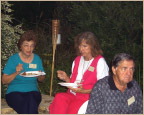Friends of the Arboretum Newsletter
Vol. 5, No. 4
Director's Letter
Silver Hat Tric
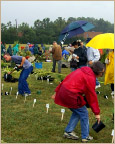 |
 |
 |
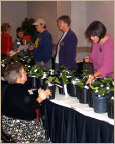 |
By Bob Lyons, Director
Welcome to the 25th anniversary issue of the JCRA Newsletter! At time of writing, details of this special edition are under wraps by our Editor, Chris Glenn, who is busy piecing together its components in an atmosphere of anticipation. That aside, we all wish you a Happy New Year.
Twenty-five years is often considered a milestone for just about anything, from weddings to graduations. The existence of the JCRA is no exception. Without a doubt, we got here through the initial and infectious passion, enthusiasm, knowledge, and vision of J. C. Raulston who founded our Arboretum in 1976. His students fanned out in all directions, coming from his own classes here at NCSU, the nursery industry, and the general public. Their commitment is envied by many of our peer institutions, and their allegiance has fueled the numerous success stories we count ourselves lucky to document. Our plant collections are a testament to a legacy of concern for landscape plant diversity and the spirit of sharing first instilled 25 years ago. I hope you enjoy the historical review provided throughout these pages and join me in looking forward to what our future holds.
By the time you read this, I will have been here for about 3 years. Not much of a significant number by itself, I guess, but its timing with this anniversary issue encourages me to recount and summarize the nature of this period; a period characterized by much continuation, change, and strengthening of our own mission and basic fabric of the JCRA itself. And, while I'm not purposely searching for some alliterative phrasing, so much of the past three years can be summed up by our people, plants, publications, programs, planning, and properties.
Although my staff and volunteers may argue that it is the plants which form our foundation, I must override their opinion and claim it is them. Simply put, we would be nowhere without their talents, innovative spirit, and dedication. The past three years have witnessed significant hiring of new staff to blend with the veterans, as well as the continued diversification and expansion of those who give so generously of their free time, our volunteers. There has been continued integration of students into our daily activities, hiring of student assistants, and creation of a unique, temporary position specifically crafted to help with our on-site work. We have been exceptionally fortunate to add an interpretive specialist and assistant director to our staff ranks, both of which are hard-funded and a testimony to the confidence placed in the JCRA by the administration of our department and college. New volunteer activities in the areas of garden curation, label engraving, and annual trials assistance, to highlight but a few, complement the already diverse and strong volunteering efforts which have characterized the JCRA for years. Mammoth tasks orchestrated by staff have also punctuated our recent past, the likes of which still amaze me. Try looking at hundreds of plants of all sizes, knowing full well that they were in the footprint of an impending, but not yet funded, 6,000+ square foot building; well, that was the west JCRA three years ago. Bottom line, the money was raised, a favorable state bond referendum passed, and most plants were either moved or propagated prior to construction of the Ruby C. McSwain Education Center. The complete renovation of the Perennial Border in 1999 was another huge benchmark, and again illustrates the quintessential spirit of the JCRA. Through the key cooperation and involvement of staff, faculty, and students, as well as JCRA volunteers and the industry, the border was taken down, distributed to Friends, redesigned, re-installed, mapped, and maintained so that it looked incredible in just one year's time. Of course there are other examples, and more to come....like acquiring a new computer mapping system (yikes!), but you get the idea! Finally, staff are encouraged to participate in professional development opportunities, with funding coming from the JCRA. Many have already traveled to national meetings, seminars, and organized tours of similar facilities.
Our plant collections are strong, growing, diverse, unique, and always under review, with great potential for even further expansion following our construction. Their relevance is being "interpreted" better and better via new printed literature, labeling, maps, tours, new outside media contacts, and a new Web site <www.ncsu.edu/jcraulstonarboretum>, all of which have been built on the strengths of the past. It is especially helpful to point to our updated, Web site based, searchable database of our plant accessions when someone simply wants to know what our collections hold....incredibly convenient even from a long distance. With regard to an overall media presence, our records show us cited about once a week in a variety of media forms. Our message is getting out, and the new faces showing up at our Friends programs prove that well. A new statewide network of plant evaluation sites is now in place to examine the landscape potential of selected species/cultivars. This network stretches the reaches of our borders and altitudes and will provide a clearer picture of selected plant performance throughout the state. Probably most importantly, we continue to provide an "open sharing" policy with certified nurseries and fellow arboreta, and we are pleased that our recent trips throughout the world have enlarged and solidified this relationship in the most mutual of ways. In cooperation with other faculty, we are formally publishing new genera and cultivar releases within refereed journals, e.g., x Sinocalycalycanthus raulstonii 'Hartlage Wine', 'Emerald Pagoda' Japanese snowbell, and 'Spring Glow' Cornelian cherry. We have also cooperated in exclusive patenting and release of four new ornamental sweet potato cultivars in the "Sweet Caroline" series. Finally, we have integrated the process of evaluating annuals into our practice and philosophy, and two reports are produced each year which document the best and worst of these important landscape plants. Yet no discussion of our plants would be complete without mention of our national and international travels in search of new species, cultivars, and horticultural contacts. Japan, California, the nation of Georgia, and the Pacific Northwest were on our recent itineraries and may never be the same after we left!
Publications? Well, I am so pleased with their quality, substance, and timeliness. The newsletters and brochures are excellent. Our partnership with "Successful Gardener" has the JCRA on the front-page of this highly awarded publication which is distributed throughout the state.
Our programs have taken on great importance for our membership, benefactors, and other sectors of the general public. In fact, I sometimes get concerned that my staff has taken on too much too soon, but they always prove me wrong! The Friends of the Arboretum Annual Plant Distribution is the most exciting benefit for our members and brings in new faces each year. Our workshops have expanded to include topics in photography (now being taken on the road, recently to Ashe County in cooperation with their Arts Council). Monthly "Plantsmen's Tours" never seem to exhaust the possible topics within our reach or satisfy the quest for plant knowledge by our members. We have partnered with national publications to bring in significant speakers (e.g., Horticulture Magazine). The new "Moonlight" in the Garden event was met with rave reviews and set the JCRA's grounds ablaze with tasteful lighting accents. "2001: A Plant Odyssey" - a symposium celebrating our 25th anniversary - brought in recognized, national experts for our own audience's education and enjoyment. We also hosted the Latino community through our El Festival del Jardin. And all this is not an exhaustive list! Hardly any of these events happen without vital input from our interpretive and computer systems staff.
Our planning efforts have given rise to a workable, feasible, and implementable long range plan, thanks in large part to the leadership within our Board of Advisors. This Board, by the way, also initiated and spearheaded our first press lunch and an infrastructure review. Many of our structures are aging, a less desirable but concomitant consequence of our 25 year history, unfortunately, and this review will help us set some priorities for repair, renovation, or replacement. The long range plan will be a road map to plan future activities and reach targeted goals, and we are making good progress already. You can read an abbreviated version of this plan in a future mailing and catch the entire text on our Web site in the near future. Planning also extends to our financial profile. The JCRA has a working annual budget in the vicinity of $150,000.00, with about two-thirds of that locked up in salaries. Each staff member now tracks his/her expenditures and receives an annual budget accordingly, which they personally administer, in addition to providing quarterly progress updates. Gala accounting is now published in entirety for our membership, and Gala revenues now directly benefit our general operations and have enabled us to kick off a new overall endowment for the JCRA totaling $10,000.00+ upon initiation.
In terms of properties, perhaps our greatest achievement in this arena has been the initiation of construction of the Ruby C. McSwain Education Center complex.....more than two-thirds done at the time of this writing! This $4.3 million project holds nothing but great promise for the JCRA, providing much needed modern office space for staff and volunteers, classrooms for formal and informal educational programs, new opportunities for revenue generation, and new spaces for new plants! Ruby McSwain's enormous donation, along with the generosity of each and every financial sponsor for selected structures and gardens, including our popular bricks, are responsible for making this project happen. We have also acquired two additional, contiguous acres directly to our east.....as-of-yet unplanned, but nonetheless secure, thanks to the College of Agriculture and Life Sciences. Our appreciation goes to our own development staff who are helped by the college office.
I suppose I could continue but fear the wrath of our Editor, Chris Glenn, who will need every bit of space possible in this newsletter to bring his vision to life! These past 3 years have been incredibly eventful for the JCRA and a real privilege for me to guide. Our agenda has been ambitious but our accomplishments have echoed that agenda closely. Our long history has identified us as a place of learning and one of personal solace, perhaps no better realized than during the recent tragedy of September 11, 2001, for which we all shared in the grief of this nation. Our thoughts are with all who suffered through this horrible event. If this at all makes literary sense, we are traveling rapidly in pursuit of our goals, and yet, stand poised on the launching pad for more incredible milestones to come. And watch out, for if you think 25 years is a long time, how many of you can vividly remember mirror balls, chic polyester clothing, the Bee Gees, the Ford Pinto, and macramé plant hangers? Then imagine the possibilities in this new age of plants and technology in the next quarter century! It's not that far away.
Timeline
A History of the Arboretum
By Christopher Todd Glenn, Nancy Doubrava, Vivian Finkelstein, and Todd Lasseigne
To celebrate our 25 years of history, presented herein for your enjoyment is a timeline of the Arboretum. We have strived to produce as accurate a history as possible. It is well known that much has happened here, but boiling it down to 131 specific "milestones" and photographs, was exceedingly difficult. We hope you enjoy it as much as we enjoyed putting it together.
![]()
![]()
![]()
![]()
![]()
![]()
![]()
![]()
![]()
![]()
![]()
![]()
![]()
![]()
![]()
Arboretum Trips
Gardens, Museums, and American Castles of Southern California
 |
 |
 |
 |
Join JCRA Director Bob Lyons, Ph.D. on an excursion to and tour of some extraordinary garden sites in the Los Angeles region of Southern California on March 10-15, 2002. Situated in a climate better known for its two seasons of "wet and dry," these gardens are quintessential examples of unique plant collections and grand opulence of days gone by. Our visit will be near the end of the rainy season which has brought on spring color in true west coast fashion.....beautiful.
Major sites planned for this trip include:
- Descanso Gardens in La Canada, Flintridge – www.descanso.com
- Hearst Castle, San Simeon – www.hearstcastle.org
- The Huntington Library, Collections, and Botanical Gardens, San Marino – www.huntington.org
- The Arboretum of Los Angeles County, Arcadia – www.arboretum.org
- The Getty Center & Gardens, Los Angeles County – www.getty.edu
The cost will be $1, 099.00 per person, double occupancy and $1,399.00 per person, single occupancy. This includes roundtrip airfare from RDU, five nights hotel accommodations, motorcoach throughout, garden and museum entrance fees, baggage handling, one dinner, and all taxes and gratuities.
For more information or to place your reservation, please call Judi Grainger of Custom Travel at (919) 872-4420. Information is also available on the Arboretum's Web site <www.ncsu.edu/jcraulstonarboretum>.
Pacific Northwest Adventureland
     |
Join Todd Lasseigne, JCRA Assistant Director, on a reprise trip visiting fabulous nurseries and gardens of the Pacific NW U.S. and British Columbia, Canada. With an unlimited palette of plants available, this trip will allow even the most avid of plantsmen and gardeners to purchase plants and stock their nurseries and gardens with many newly introduced gems.
Dates: July 13-23, 2002 – Tour limited to 40 participants.
Approximate Cost: $2,200.00 (includes airfare from Raleigh, NC and all other costs except meals and other items purchased by participants)
Highlights of the trip will include:
- University of British Columbia Botanical Garden, Vancouver, BC
- Heronswood Nursery, Kingston, WA
- Stanley and Sons Nursery, Boring, OR
- Portland Classical Chinese Garden, Portland, OR
- The Oregon Garden, Silverton, OR
- Washington Park Arboretum, Seattle, WA
- Elizabeth Carey Miller Botanical Garden, Seattle, WA
- Vandusen Botanical Garden, Vancouver, BC
- South Seattle Community College Arboretum, Seattle, WA
- And over 12 other nurseries to be announced.
For information or to make reservations, call Judi Grainger of Custom Travel at (919) 872-4420, or contact Todd <todd_lasseigne@ncsu.edu> for further details. Information will also be posted on the JCRA Web site <www.ncsu.edu/jcraulstonarboretum>.
Horticulture
Display of New and Promising Acquisitions
By Todd Lasseigne, Assistant Director
Southern Nursery Association Annual Convention and Trade Show
Atlanta, Georgia
August 3-5, 2001
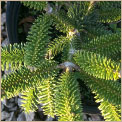 1) Abies pinsapo var. marocana - Moroccan fir - The search for heat tolerant firs at the JCRA
has led to A. firma, the Momi fir of Japan. However, other
avenues remain unexplored, such as the firs of the circum-Mediterranean Basin.
Moroccan fir represents one of several species that we have acquired to test
for landscape use and ornamental value in Raleigh. This rare and little known
fir displays rich, dark green needles set on a dense, symmetrical crown. As
it is native to the Atlas Mountains of northern Africa, we are hoping that it
will prove adaptable to our climate. This specimen is grafted onto A. firma rootstock and was donated by Porterhowse Nursery (Sandy, OR).
1) Abies pinsapo var. marocana - Moroccan fir - The search for heat tolerant firs at the JCRA
has led to A. firma, the Momi fir of Japan. However, other
avenues remain unexplored, such as the firs of the circum-Mediterranean Basin.
Moroccan fir represents one of several species that we have acquired to test
for landscape use and ornamental value in Raleigh. This rare and little known
fir displays rich, dark green needles set on a dense, symmetrical crown. As
it is native to the Atlas Mountains of northern Africa, we are hoping that it
will prove adaptable to our climate. This specimen is grafted onto A. firma rootstock and was donated by Porterhowse Nursery (Sandy, OR).
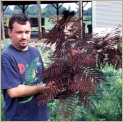 2) Albizia julibrissin 'Summer Chocolate' - purple-leaf mimosa - Perhaps the most anticipated new woody plant in years,
those plantsmen who have been fortunate enough to see the fabled purple-leaf
mimosa have eagerly awaited its introduction into the U.S. nursery trade. Our
plant was a gift from Mike Ishii of Ishii Plants (Saitama City,
Japan), representing newly strengthened ties between the JCRA and the Japanese
Tree Growers Association, who hold many other equally wonderful plants. Watch
for this fine ornamental tree to enter the market soon. 'Summer Chocolate' was
discovered years ago by the great purveyor of variegated plants in Japan, Masato
Yokoi.
2) Albizia julibrissin 'Summer Chocolate' - purple-leaf mimosa - Perhaps the most anticipated new woody plant in years,
those plantsmen who have been fortunate enough to see the fabled purple-leaf
mimosa have eagerly awaited its introduction into the U.S. nursery trade. Our
plant was a gift from Mike Ishii of Ishii Plants (Saitama City,
Japan), representing newly strengthened ties between the JCRA and the Japanese
Tree Growers Association, who hold many other equally wonderful plants. Watch
for this fine ornamental tree to enter the market soon. 'Summer Chocolate' was
discovered years ago by the great purveyor of variegated plants in Japan, Masato
Yokoi.
 3) Berberis buxifolia 'Pygmaea' (syn. 'Nana') - boxleaf barberry - In our goal to expand the JCRA's Berberis collection, a group that holds strong economic value for the nursery industry,
but one that is vastly untapped, we came across this interesting semi-evergreen
species native to southern Chile. Although Chilean plants are not generally
inclined to the southern U.S. climate, we are intrigued enough by the possibilities
of this low-growing (2-3 feet tall) shrub to try and find out about its hardiness
and garden merit. References rate the species as hardy to Zones 5 or 6, but
we remain skeptical. Our plant was procured from Forestfarm Nursery (Williams,
OR).
3) Berberis buxifolia 'Pygmaea' (syn. 'Nana') - boxleaf barberry - In our goal to expand the JCRA's Berberis collection, a group that holds strong economic value for the nursery industry,
but one that is vastly untapped, we came across this interesting semi-evergreen
species native to southern Chile. Although Chilean plants are not generally
inclined to the southern U.S. climate, we are intrigued enough by the possibilities
of this low-growing (2-3 feet tall) shrub to try and find out about its hardiness
and garden merit. References rate the species as hardy to Zones 5 or 6, but
we remain skeptical. Our plant was procured from Forestfarm Nursery (Williams,
OR).
 4) Berberis gagnepainii - Gagnepain barberry
- As a good, low, screening hedge candidate, this evergreen barberry represents
yet another of the approximately 600 species of Berberis that is worthy
of trialing in the southeastern U.S. for potential landscape use. Gagnepain
barberry forms a dense, low shrub, set with narrow, wavy-margined foliage and
blue-black fruits. Although this species has been known in Western cultivation
since its introduction in the early 1900s, it has been grown by only a select
few arboreta and botanical gardens. Our plant came from Forestfarm Nursery (Williams,
OR).
4) Berberis gagnepainii - Gagnepain barberry
- As a good, low, screening hedge candidate, this evergreen barberry represents
yet another of the approximately 600 species of Berberis that is worthy
of trialing in the southeastern U.S. for potential landscape use. Gagnepain
barberry forms a dense, low shrub, set with narrow, wavy-margined foliage and
blue-black fruits. Although this species has been known in Western cultivation
since its introduction in the early 1900s, it has been grown by only a select
few arboreta and botanical gardens. Our plant came from Forestfarm Nursery (Williams,
OR).
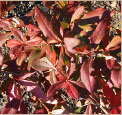 5) Berberis henryana - Henry barberry - Henry
barberry is presented here as an example of the rich diversity of barberries
native to western China. Since most barberries are poorly known in North America,
little information exists on their landscape or field performance. Berberis
henryana forms medium-statured, deciduous shrubs and produces
abundant red berries in autumn. On tough, exposed, dry sites, barberries will
prosper while other shrubs falter. Green-leaved types (such as B. henryana) can display fall color that rivals other
common shrubs. Clearly, this is a group that merits further attention.
5) Berberis henryana - Henry barberry - Henry
barberry is presented here as an example of the rich diversity of barberries
native to western China. Since most barberries are poorly known in North America,
little information exists on their landscape or field performance. Berberis
henryana forms medium-statured, deciduous shrubs and produces
abundant red berries in autumn. On tough, exposed, dry sites, barberries will
prosper while other shrubs falter. Green-leaved types (such as B. henryana) can display fall color that rivals other
common shrubs. Clearly, this is a group that merits further attention.
 6) Berberis lempergiana - evergreen barberry
- An example of a recent acquisition that we are trialing in our expansion of
the Berberis collection at the JCRA, B. lempergiana represents a relative to the somewhat still commonly grown B. julianae (wintergreen barberry). We are impressed thus far by the foliage qualities -
evergreen, somewhat bolder than that of B. julianae. Not for
the faint-of-heart, this plant also comes well armed, but holds promise for
landscape situations where a tough, impenetrable low screen is needed. Hardiness
is unknown, so stay tuned for more information as it is elucidated. Acquired
from Heronswood Nursery (Kingston, WA).
6) Berberis lempergiana - evergreen barberry
- An example of a recent acquisition that we are trialing in our expansion of
the Berberis collection at the JCRA, B. lempergiana represents a relative to the somewhat still commonly grown B. julianae (wintergreen barberry). We are impressed thus far by the foliage qualities -
evergreen, somewhat bolder than that of B. julianae. Not for
the faint-of-heart, this plant also comes well armed, but holds promise for
landscape situations where a tough, impenetrable low screen is needed. Hardiness
is unknown, so stay tuned for more information as it is elucidated. Acquired
from Heronswood Nursery (Kingston, WA).
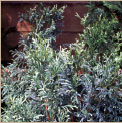 7) Calocedrus macrolepis - Chinese incense-cedar
- At the JCRA, we are always on the lookout for new screening evergreens. In
this regard, we have seen C. decurrens (California incense-cedar)
used successfully in several southern and mid-Atlantic states. However, it is
only through recent plant expeditions conducted by Heronswood Nursery (Kingston,
WA) that new germplasm of this sister Chinese species has become available.
Chinese incense-cedar forms an upright evergreen tree or tall hedge/screen with
rich blue-green foliage. We have been pleasantly surprised with the performance
of several Asian Cupressaceae and expect nothing less from this species.
7) Calocedrus macrolepis - Chinese incense-cedar
- At the JCRA, we are always on the lookout for new screening evergreens. In
this regard, we have seen C. decurrens (California incense-cedar)
used successfully in several southern and mid-Atlantic states. However, it is
only through recent plant expeditions conducted by Heronswood Nursery (Kingston,
WA) that new germplasm of this sister Chinese species has become available.
Chinese incense-cedar forms an upright evergreen tree or tall hedge/screen with
rich blue-green foliage. We have been pleasantly surprised with the performance
of several Asian Cupressaceae and expect nothing less from this species.
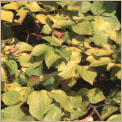 8) Celtis aurantiaca - Chinese hackberry - Currently,
exchange of many new or lesser-known plants around the world is greatly facilitated
by a common sharing of seeds among botanical institutions, these being referred
to as "Index Semina" (literally, "seed list"). This hackberry
was sent to us as seed by a Chinese botanical garden, with only 2 or 3 seeds
germinating. Since the Asian hackberries have been highly impressive for their
growth rates and foliage qualities (especially C. bungeana, C. choseniana, and C. sinensis), we are
watching this species to assess its garden performance and stress/disease/insect
tolerance. Stay tuned! Pictured here is the equally splendid C. choseniana.
8) Celtis aurantiaca - Chinese hackberry - Currently,
exchange of many new or lesser-known plants around the world is greatly facilitated
by a common sharing of seeds among botanical institutions, these being referred
to as "Index Semina" (literally, "seed list"). This hackberry
was sent to us as seed by a Chinese botanical garden, with only 2 or 3 seeds
germinating. Since the Asian hackberries have been highly impressive for their
growth rates and foliage qualities (especially C. bungeana, C. choseniana, and C. sinensis), we are
watching this species to assess its garden performance and stress/disease/insect
tolerance. Stay tuned! Pictured here is the equally splendid C. choseniana.
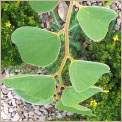 9) Celtis julianae - Julian hackberry - As yet
another example of the wonderful diversity of Asian hackberries, we recently
acquired this species. Being a deciduous tree of medium to large stature, nothing
really stands out from a casual perusing of any specialty nursery catalog when
it comes to this plant. However, upon receiving our specimen (in a dormant state)
and subsequently observing the new growth, wherein the leaves are covered in
a dense mat of gold-brown pubescence, we were smitten. This very exciting new
hackberry was supplied to us by ArborVillage Nursery (Holt, MO).
9) Celtis julianae - Julian hackberry - As yet
another example of the wonderful diversity of Asian hackberries, we recently
acquired this species. Being a deciduous tree of medium to large stature, nothing
really stands out from a casual perusing of any specialty nursery catalog when
it comes to this plant. However, upon receiving our specimen (in a dormant state)
and subsequently observing the new growth, wherein the leaves are covered in
a dense mat of gold-brown pubescence, we were smitten. This very exciting new
hackberry was supplied to us by ArborVillage Nursery (Holt, MO).
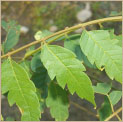 10) Choerospondias axillaris - Chinese false-sumac
- This deciduous tree is a practically unknown member of the sumac or pistachio
family. Received by us as a seedling derived from a Chinese index seminum (seed
list of a botanical garden), we have been observing the fast growth rate and
good summer foliage color on the attractive pinnately compound leaves. If this
turns out to be a nonsuckering, deciduous shrub displaying the fall color we
have come to expect from the sumacs and pistachios, a winner may indeed be in
our hands here.
10) Choerospondias axillaris - Chinese false-sumac
- This deciduous tree is a practically unknown member of the sumac or pistachio
family. Received by us as a seedling derived from a Chinese index seminum (seed
list of a botanical garden), we have been observing the fast growth rate and
good summer foliage color on the attractive pinnately compound leaves. If this
turns out to be a nonsuckering, deciduous shrub displaying the fall color we
have come to expect from the sumacs and pistachios, a winner may indeed be in
our hands here.
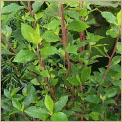 11) Clethra alnifolia 'Sherry Sue' - redtwig summersweet - On the native plants front, much activity (as always)
is occurring. Clethras, as one of the recent native plant success stories,
have proliferated, with many cultivars (e.g., 'Hummingbird', 'Ruby Spice', etc.)
now available. Yet, none of these cultivars of C. alnifolia displays the rich stem coloration found in 'Sherry Sue', a cultivar originating
from Dodd and Dodd Nursery (Semmes, AL). 'Sherry Sue' displays bright pinkish-red
twigs throughout the growing season. The pink pigment also grades into the inflorescence,
yielding pink tones to the flowers. An exciting new frontier for summersweet
clethra.
11) Clethra alnifolia 'Sherry Sue' - redtwig summersweet - On the native plants front, much activity (as always)
is occurring. Clethras, as one of the recent native plant success stories,
have proliferated, with many cultivars (e.g., 'Hummingbird', 'Ruby Spice', etc.)
now available. Yet, none of these cultivars of C. alnifolia displays the rich stem coloration found in 'Sherry Sue', a cultivar originating
from Dodd and Dodd Nursery (Semmes, AL). 'Sherry Sue' displays bright pinkish-red
twigs throughout the growing season. The pink pigment also grades into the inflorescence,
yielding pink tones to the flowers. An exciting new frontier for summersweet
clethra.
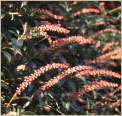 12) Clethra delavayi - Delavay summersweet -
Although the recent rise to stardom of our native C. alnifolia and its now myriad cultivars is common knowledge to southern nurseries, little
attention has been paid to the rich diversity of Clethra that hail
from Asia. Since C. delavayi is widely observable in many
of the fabulous arboreta of Great Britain but is notably absent from eastern
U.S. gardens, it was wonderful to see wild-collected germplasm made available
recently by Heronswood Nursery (Kingston, WA), from which we procured this plant
last year. C. delavayi bears rich dark green foliage and inflorescences
that are consistently tinged pink.
12) Clethra delavayi - Delavay summersweet -
Although the recent rise to stardom of our native C. alnifolia and its now myriad cultivars is common knowledge to southern nurseries, little
attention has been paid to the rich diversity of Clethra that hail
from Asia. Since C. delavayi is widely observable in many
of the fabulous arboreta of Great Britain but is notably absent from eastern
U.S. gardens, it was wonderful to see wild-collected germplasm made available
recently by Heronswood Nursery (Kingston, WA), from which we procured this plant
last year. C. delavayi bears rich dark green foliage and inflorescences
that are consistently tinged pink.
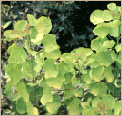 13) Cotinus coggygria 'Ancot' - Golden Spirit™ goldleaf smokebush - As one of the most exciting new woody
plants to hit the market in years, goldleaf smokebush is sure to garner high
sales in the U.S. in time. Acquired in 1999 directly from the U.K., our plant
at the JCRA now prospers, exhibiting vigorous growth and excellent tolerance
to bright, nearly full sun conditions without any leaf scorch. The foliage emerges
gold-yellow and retains this color throughout the growing season. Fall tints
have been observed as rich red-purple hues on our young plant. (A patented plant.)
13) Cotinus coggygria 'Ancot' - Golden Spirit™ goldleaf smokebush - As one of the most exciting new woody
plants to hit the market in years, goldleaf smokebush is sure to garner high
sales in the U.S. in time. Acquired in 1999 directly from the U.K., our plant
at the JCRA now prospers, exhibiting vigorous growth and excellent tolerance
to bright, nearly full sun conditions without any leaf scorch. The foliage emerges
gold-yellow and retains this color throughout the growing season. Fall tints
have been observed as rich red-purple hues on our young plant. (A patented plant.)
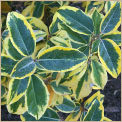 14) Elaeagnus ×ebbingei 'Gilt Edge' - variegated eleagnus - Long admired by British
gardeners and nurserymen, 'Gilt Edge' eleagnus is surprisingly scarcely known
among southern U.S. nurseries. In August 2000, we procured this specimen from
Greer Gardens (Eugene, OR), as there are no recent records of the plant being
grown at the JCRA. In foliage effect, the variegation of 'Gilt Edge' rivals
that of the E. pungens cultivars - 'Maculata', 'Frederici',
and 'Dicksonii'. Furthermore, the hybrid origin may act to decrease the likelihood
of seedlings being produced - an emerging problem of potential invasiveness
with E. pungens.
14) Elaeagnus ×ebbingei 'Gilt Edge' - variegated eleagnus - Long admired by British
gardeners and nurserymen, 'Gilt Edge' eleagnus is surprisingly scarcely known
among southern U.S. nurseries. In August 2000, we procured this specimen from
Greer Gardens (Eugene, OR), as there are no recent records of the plant being
grown at the JCRA. In foliage effect, the variegation of 'Gilt Edge' rivals
that of the E. pungens cultivars - 'Maculata', 'Frederici',
and 'Dicksonii'. Furthermore, the hybrid origin may act to decrease the likelihood
of seedlings being produced - an emerging problem of potential invasiveness
with E. pungens.
 15) Elaeagnus 'Quicksilver' - silverbush eleagnus - Originating in England as a chance hybrid seedling,
and later recognized and named by British plantsman Roy Lancaster,
'Quicksilver' displays striking foliage on a deciduous, fast-growing shrub.
As other deciduous Elaeagnus species have proven to be invasive pests
around the U.S., we are looking to 'Quicksilver' as a potential sterile alternative
- a silver-leaf shrub suitable for screening and for use on poor or infertile
soils due to the plant's ability to fix atmospheric nitrogen. Our specimen derives
from Heronswood Nursery (Kingston, WA). Pictured here is E. multiflora,
a species similar in appearance to 'Quicksilver' but with greener instead of
silver leaves. However, we do not recommend the use of E. multiflora because of weediness concerns.
15) Elaeagnus 'Quicksilver' - silverbush eleagnus - Originating in England as a chance hybrid seedling,
and later recognized and named by British plantsman Roy Lancaster,
'Quicksilver' displays striking foliage on a deciduous, fast-growing shrub.
As other deciduous Elaeagnus species have proven to be invasive pests
around the U.S., we are looking to 'Quicksilver' as a potential sterile alternative
- a silver-leaf shrub suitable for screening and for use on poor or infertile
soils due to the plant's ability to fix atmospheric nitrogen. Our specimen derives
from Heronswood Nursery (Kingston, WA). Pictured here is E. multiflora,
a species similar in appearance to 'Quicksilver' but with greener instead of
silver leaves. However, we do not recommend the use of E. multiflora because of weediness concerns.
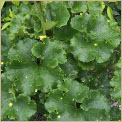 16) Farfugium japonicum 'Kagami Jishi' (syn. Ligularia tussilaginea 'Kagami Jishi') - crested leopard plant
- A superb new perennial suited for the southern U.S., 'Kagami Jishi' combines
the best of both worlds - the crested foliage of 'Crispata' with the speckled
variegation of 'Aureomaculata'. Few other shade perennials can match this for
visual impact. As plants age, the foliage develops better cresting along the
margins. One of several new cultivars introduced from Japan where they have
been long cultivated. Our plant was kindly donated by Caimen Gardens (Manteo,
NC).
16) Farfugium japonicum 'Kagami Jishi' (syn. Ligularia tussilaginea 'Kagami Jishi') - crested leopard plant
- A superb new perennial suited for the southern U.S., 'Kagami Jishi' combines
the best of both worlds - the crested foliage of 'Crispata' with the speckled
variegation of 'Aureomaculata'. Few other shade perennials can match this for
visual impact. As plants age, the foliage develops better cresting along the
margins. One of several new cultivars introduced from Japan where they have
been long cultivated. Our plant was kindly donated by Caimen Gardens (Manteo,
NC).
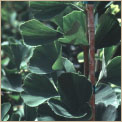 17) Ginkgo biloba 'Jade Butterfly' - dwarf ginkgo - One of several new, dwarf cultivars, 'Jade Butterfly' represents
a new direction for ginkgos in the U.S. Our plant, recently obtained from Stanley
and Sons Nursery (Boring, OR), displays a dense growth habit with attractive
bunched or tufted foliage, each leaf resembling butterfly wings. Although ultimate
size is unknown since this cultivar is recently introduced and named, some estimates
state that 10 year-old specimens can reach only 10 feet tall. This cultivar
originated from the famed Duncan and Davies Nursery of New Zealand.
17) Ginkgo biloba 'Jade Butterfly' - dwarf ginkgo - One of several new, dwarf cultivars, 'Jade Butterfly' represents
a new direction for ginkgos in the U.S. Our plant, recently obtained from Stanley
and Sons Nursery (Boring, OR), displays a dense growth habit with attractive
bunched or tufted foliage, each leaf resembling butterfly wings. Although ultimate
size is unknown since this cultivar is recently introduced and named, some estimates
state that 10 year-old specimens can reach only 10 feet tall. This cultivar
originated from the famed Duncan and Davies Nursery of New Zealand.
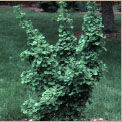 18) Ginkgo biloba 'WB' - dwarf
ginkgo - This outstanding new ginkgo is derived from a witch's broom (hence
'WB') mutation that was subsequently cloned. Mature plants exhibit an exceedingly
dwarf frame and highly architectural branching structure - creating a "bonsai"
effect in the landscape. Growth rates in landscape settings are slow - 2 to
4 inches per year - but in production, under irrigation and high fertility,
are reasonable. Our plant hails from Stanley and Sons Nursery (Boring, OR),
a grower of this and several other new dwarf cultivars. A striking new and exciting
departure in the world of ginkgos.
18) Ginkgo biloba 'WB' - dwarf
ginkgo - This outstanding new ginkgo is derived from a witch's broom (hence
'WB') mutation that was subsequently cloned. Mature plants exhibit an exceedingly
dwarf frame and highly architectural branching structure - creating a "bonsai"
effect in the landscape. Growth rates in landscape settings are slow - 2 to
4 inches per year - but in production, under irrigation and high fertility,
are reasonable. Our plant hails from Stanley and Sons Nursery (Boring, OR),
a grower of this and several other new dwarf cultivars. A striking new and exciting
departure in the world of ginkgos.
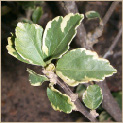 19) Hibiscus syriacus 'Meehanii' - variegated rose-of-Sharon - For years at the JCRA, we have grown H. syriacus 'Purpureis Variegatus', a splendid variegated rose-of-Sharon
that does not exhibit leaf scorch but unfortunately produces flowers that do
not open. 'Meehanii', long grown in Europe, offers similarly attractive variegated
foliage, but with blue-purple flowers that open wide like "normal" H. syriacus cultivars. Evidently, this cultivar was brought
to the Arboretum from the U.K. by J. C. Raulston, but was later lost. Thanks
to Sam Allen of Tarheel Native Trees (Clayton, NC), who has
long grown this cultivar, J. C.'s efforts in procuring the plant were not in
vain.
19) Hibiscus syriacus 'Meehanii' - variegated rose-of-Sharon - For years at the JCRA, we have grown H. syriacus 'Purpureis Variegatus', a splendid variegated rose-of-Sharon
that does not exhibit leaf scorch but unfortunately produces flowers that do
not open. 'Meehanii', long grown in Europe, offers similarly attractive variegated
foliage, but with blue-purple flowers that open wide like "normal" H. syriacus cultivars. Evidently, this cultivar was brought
to the Arboretum from the U.K. by J. C. Raulston, but was later lost. Thanks
to Sam Allen of Tarheel Native Trees (Clayton, NC), who has
long grown this cultivar, J. C.'s efforts in procuring the plant were not in
vain.
 20) Hydrangea integrifolia - evergreen climbing
hydrangea - With deciduous climbing hydrangeas now accepted as garden plants
in the U.S., we have taken a closer look at the genus Hydrangea to
see what other wonders await discovery, and a host of evergreen species has
come to our attention. Hydrangea integrifolia, a Taiwanese species,
is only one of several species that we have recently acquired and will be testing
for its performance at the JCRA. Plants display lustrous dark green foliage
and white flowers in lace-cap configuration. Heronswood Nursery (Kingston, WA),
from where our plant came, considers this one of the most beautiful vines they
grow.
20) Hydrangea integrifolia - evergreen climbing
hydrangea - With deciduous climbing hydrangeas now accepted as garden plants
in the U.S., we have taken a closer look at the genus Hydrangea to
see what other wonders await discovery, and a host of evergreen species has
come to our attention. Hydrangea integrifolia, a Taiwanese species,
is only one of several species that we have recently acquired and will be testing
for its performance at the JCRA. Plants display lustrous dark green foliage
and white flowers in lace-cap configuration. Heronswood Nursery (Kingston, WA),
from where our plant came, considers this one of the most beautiful vines they
grow.
 21) Hydrangea involucrata - bracted hydrangea
- This deciduous, tall, shrubby hydrangea remains virtually unknown in American
gardens and nurseries. With the huge interest in hydrangeas presently, we are
investigating the performance of several species. Hydrangea involucrata holds promise for its lavender-pink to white flower heads enclosed by colored
bud scales (or bracts) before opening, and large, bold foliage. However, since
it has been only limitedly grown, stress tolerance is unknown. Our plant is
derived from wild collected germplasm from a Heronswood Nursery (Kingston, WA)
expedition.
21) Hydrangea involucrata - bracted hydrangea
- This deciduous, tall, shrubby hydrangea remains virtually unknown in American
gardens and nurseries. With the huge interest in hydrangeas presently, we are
investigating the performance of several species. Hydrangea involucrata holds promise for its lavender-pink to white flower heads enclosed by colored
bud scales (or bracts) before opening, and large, bold foliage. However, since
it has been only limitedly grown, stress tolerance is unknown. Our plant is
derived from wild collected germplasm from a Heronswood Nursery (Kingston, WA)
expedition.
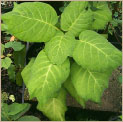 22) Hydrangea sikokiana - Japanese oakleaf hydrangea
- Also deriving from a Heronswood Nursery (Kingston, WA) expedition, H. sikokiana has been perhaps the most obviously overlooked Japanese native
plant in the North American garden flora. As the sister species to our oakleaf
hydrangea (H. quercifolia), H. sikokiana also displays large pyramidal-shaped inflorescences. Leaves are not so deeply
lobed as those of our native but do display the textural interest lacking in
many other hydrangeas. The light green leaves suggest that some shade may be
beneficial for best garden performance. A plant to watch!
22) Hydrangea sikokiana - Japanese oakleaf hydrangea
- Also deriving from a Heronswood Nursery (Kingston, WA) expedition, H. sikokiana has been perhaps the most obviously overlooked Japanese native
plant in the North American garden flora. As the sister species to our oakleaf
hydrangea (H. quercifolia), H. sikokiana also displays large pyramidal-shaped inflorescences. Leaves are not so deeply
lobed as those of our native but do display the textural interest lacking in
many other hydrangeas. The light green leaves suggest that some shade may be
beneficial for best garden performance. A plant to watch!
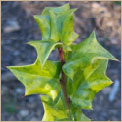 23) Ilex ×aquipernyi (variegated) - variegated Aquipern holly - Acquired several
years ago from Michael Dirr, we have since been watching this
speckled, variegated form of Aquipern holly, as we are always on the lookout
for new variegated evergreen shrubs. Our plants exhibit moderate growth rates
and a stable maintenance of the variegation pattern. Although some foliar bleaching
has occurred in full-sun conditions, this plant may hold some potential as a
part-shade evergreen useful for lighting up dark corners.
23) Ilex ×aquipernyi (variegated) - variegated Aquipern holly - Acquired several
years ago from Michael Dirr, we have since been watching this
speckled, variegated form of Aquipern holly, as we are always on the lookout
for new variegated evergreen shrubs. Our plants exhibit moderate growth rates
and a stable maintenance of the variegation pattern. Although some foliar bleaching
has occurred in full-sun conditions, this plant may hold some potential as a
part-shade evergreen useful for lighting up dark corners.
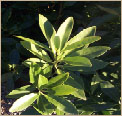 24) Illicium parviflorum 'Forest Green' - 'Forest Green' yellow anise-tree - This fine Illicium is an introduction
of Michael Dirr, and one that unfortunately has not received its just amount
of attention. 'Forest Green', considered an improvement over typical I. parviflorum due to its maintenance of darker green foliage, even in
full sun, should be adopted as the standard bearer for this species, replacing
the chartreuse-green form that is commonly grown. We have been amazed with this
plant's performance under stressful growing conditions. Research from the Ph.D.
program of Jason Griffin at NCSU has shown that this is the most sun tolerant
of all the Illiciums.
24) Illicium parviflorum 'Forest Green' - 'Forest Green' yellow anise-tree - This fine Illicium is an introduction
of Michael Dirr, and one that unfortunately has not received its just amount
of attention. 'Forest Green', considered an improvement over typical I. parviflorum due to its maintenance of darker green foliage, even in
full sun, should be adopted as the standard bearer for this species, replacing
the chartreuse-green form that is commonly grown. We have been amazed with this
plant's performance under stressful growing conditions. Research from the Ph.D.
program of Jason Griffin at NCSU has shown that this is the most sun tolerant
of all the Illiciums.
 25) Illicium 'Woodland Ruby' - pink anise-tree - This stunning evergreen shrub originated at Woodlanders
Nursery (Aiken, SC) as a chance hybrid between the red-flowered I. mexicanum and the white-flowered I. floridanum f. album. Truly inheriting the best of both worlds, 'Woodland Ruby' displays
masses of pink flowers that are produced in spring and fall months, and even
through the summer. (This rebloom is derived from I. mexicanum.)
Jason Griffin's research on stress physiology in the Illiciums
has shown that 'Woodland Ruby' is one of the most vigorous of all the anise-trees.
25) Illicium 'Woodland Ruby' - pink anise-tree - This stunning evergreen shrub originated at Woodlanders
Nursery (Aiken, SC) as a chance hybrid between the red-flowered I. mexicanum and the white-flowered I. floridanum f. album. Truly inheriting the best of both worlds, 'Woodland Ruby' displays
masses of pink flowers that are produced in spring and fall months, and even
through the summer. (This rebloom is derived from I. mexicanum.)
Jason Griffin's research on stress physiology in the Illiciums
has shown that 'Woodland Ruby' is one of the most vigorous of all the anise-trees.
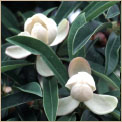 26) Manglietia yunnanensis - Yunnan wood-lotus
- This evergreen relative of our southern magnolia (Magnolia grandiflora)
continues to amaze us at the JCRA. Now standing 15 to 20 feet tall, while only
8 feet wide, our original specimen (12 years old) stands as a striking evergreen
flowering tree worthy of use in any modern urban landscape. This year we were
wildly successful in germinating a large number of seeds, opening the door for
future testing, evaluation, and distribution. Since cutting propagation has
proven difficult, we plan on experimenting with a subset of the seedlings we
now have to elucidate protocols for clonal propagation.
26) Manglietia yunnanensis - Yunnan wood-lotus
- This evergreen relative of our southern magnolia (Magnolia grandiflora)
continues to amaze us at the JCRA. Now standing 15 to 20 feet tall, while only
8 feet wide, our original specimen (12 years old) stands as a striking evergreen
flowering tree worthy of use in any modern urban landscape. This year we were
wildly successful in germinating a large number of seeds, opening the door for
future testing, evaluation, and distribution. Since cutting propagation has
proven difficult, we plan on experimenting with a subset of the seedlings we
now have to elucidate protocols for clonal propagation.
 27) Pinus virginiana 'Issaqueena' - dwarf Virginia pine - This plant serves to illustrate one group of southern
natives that are grossly overlooked for selection and development of new cultivars
- the southern pines. This dwarf cultivar represents one of several recently
named cultivars that has potential in developing stress tolerant alternatives
to mugo pine for southern landscapes. Despite our rich heritage of pines in
the Southeast, few or no cultivars exist for most of the species. This plant,
acquired from Stanley and Sons Nursery (Boring, OR), shows the potential worth
of selecting improved forms of these natives.
27) Pinus virginiana 'Issaqueena' - dwarf Virginia pine - This plant serves to illustrate one group of southern
natives that are grossly overlooked for selection and development of new cultivars
- the southern pines. This dwarf cultivar represents one of several recently
named cultivars that has potential in developing stress tolerant alternatives
to mugo pine for southern landscapes. Despite our rich heritage of pines in
the Southeast, few or no cultivars exist for most of the species. This plant,
acquired from Stanley and Sons Nursery (Boring, OR), shows the potential worth
of selecting improved forms of these natives.
 28) Prunus laurocerasus 'Kelpie' - gold-variegated common cherrylaurel - Always on the lookout for new variegated
broadleaf evergreen shrubs, we came across this cultivar of cherrylaurel at
Heronswood Nursery (Kingston, WA) in August 2000. Differing from both 'Variegata'
and 'Castlewellan' (formerly called 'Marbled White'), 'Kelpie' displays rich,
gold-suffused leaves, whereas the former both display white-mottled variegation.
Presently, little other information as to the origin of this plant is known
to us. Some leaf scorch has been observed in full-sun conditions, and ultimate
size is unknown.
28) Prunus laurocerasus 'Kelpie' - gold-variegated common cherrylaurel - Always on the lookout for new variegated
broadleaf evergreen shrubs, we came across this cultivar of cherrylaurel at
Heronswood Nursery (Kingston, WA) in August 2000. Differing from both 'Variegata'
and 'Castlewellan' (formerly called 'Marbled White'), 'Kelpie' displays rich,
gold-suffused leaves, whereas the former both display white-mottled variegation.
Presently, little other information as to the origin of this plant is known
to us. Some leaf scorch has been observed in full-sun conditions, and ultimate
size is unknown.
 29) Rubus ursinus 'Variegatus' - variegated dewberry - As groundcovers go, there is rarely a new introduction
that catches on to any significant degree. This variegated dewberry, although
not evergreen, does merit attention as a vining groundcover with attractive
foliage, a surprisingly fast growth rate for a variegated plant, and edible
fruit. The leaves, margined white, echo the white flowers in spring, and later
contrast effectively with the small fruits that age from green to red to black-purple
akin to our native dewberries. We found a lone specimen of this plant for sale
at Greer Gardens (Eugene, OR) in August 2000.
29) Rubus ursinus 'Variegatus' - variegated dewberry - As groundcovers go, there is rarely a new introduction
that catches on to any significant degree. This variegated dewberry, although
not evergreen, does merit attention as a vining groundcover with attractive
foliage, a surprisingly fast growth rate for a variegated plant, and edible
fruit. The leaves, margined white, echo the white flowers in spring, and later
contrast effectively with the small fruits that age from green to red to black-purple
akin to our native dewberries. We found a lone specimen of this plant for sale
at Greer Gardens (Eugene, OR) in August 2000.
 30) Styrax japonicus 'Rubra Pendula' - weeping Japanese snowbell - Newly introduced to the U.S., this cultivar represents
one of the pink-flowering weeping Japanese snowbells discovered and grown in
Japan. Through the efforts of Saul Nurseries' Ozzie Johnson,
we acquired this plant from Akira Shibamichi of Shibamichi
Nursery (Kawaguchi City, Japan) in 1999. Now planted out at the JCRA, our specimen
has flourished, exhibiting rapid growth rates and good dark green summer foliage.
Unfortunately, the pink floral pigments have not developed in our warm springs
- a problem that we are investigating.
30) Styrax japonicus 'Rubra Pendula' - weeping Japanese snowbell - Newly introduced to the U.S., this cultivar represents
one of the pink-flowering weeping Japanese snowbells discovered and grown in
Japan. Through the efforts of Saul Nurseries' Ozzie Johnson,
we acquired this plant from Akira Shibamichi of Shibamichi
Nursery (Kawaguchi City, Japan) in 1999. Now planted out at the JCRA, our specimen
has flourished, exhibiting rapid growth rates and good dark green summer foliage.
Unfortunately, the pink floral pigments have not developed in our warm springs
- a problem that we are investigating.
 31) Thujopsis dolabrata 'Aurea' - golden false arborvitae - This is the rarely seen gold-leaf form of false
arborvitae. Typical (green-leaf) T. dolabrata forms huge trees
in cool-temperate gardens; while plants in the southeastern U.S. tend to be
smaller, at best seen as screening hedges. Since 'Aurea' is not widely grown,
its ultimate size and performance in our climate remains unknown, but we expect
'Aurea' will form a pyramidal shrub. Close inspection reveals the contrast between
the rich yellow-gold upper leaf surface versus the striking white markings beneath.
Acquired from Stanley and Sons Nursery (Boring, OR).
31) Thujopsis dolabrata 'Aurea' - golden false arborvitae - This is the rarely seen gold-leaf form of false
arborvitae. Typical (green-leaf) T. dolabrata forms huge trees
in cool-temperate gardens; while plants in the southeastern U.S. tend to be
smaller, at best seen as screening hedges. Since 'Aurea' is not widely grown,
its ultimate size and performance in our climate remains unknown, but we expect
'Aurea' will form a pyramidal shrub. Close inspection reveals the contrast between
the rich yellow-gold upper leaf surface versus the striking white markings beneath.
Acquired from Stanley and Sons Nursery (Boring, OR).
Development
An Enlightening Experience - Second Annual "Moonlight" in the Garden
By Donna Walker, Development Associate
Corporate
Sponsors |
To begin preparation for the 2001 "Moonlight" in the Garden event, John Garner and his team of garden lighting experts from Southern Lights in Raleigh took over a large part of the east JCRA beginning the second week of September. They ran cable and installed uplights, downlights, spotlights, and special light fixtures. By the time the volunteers arrived for a special walk-through, the Arboretum had been transformed into a wonderland.
On Friday and Saturday nights, with perfect weather and an almost full moon, crowds came to see the JCRA in a new light, no pun intended. In front of a backdrop of fall decorations, John greeted each group with a few words about his creation. Donna Walker welcomed everyone to the JCRA, and folks began the tour.
Small copper lights, which lit the entry arbor and path, began the walk through the gardens. Susan Cheatham, curator of the Klein-Pringle White Garden, waited for each group and spoke a few words about the special things in the garden and described what John had done there. Susan also managed to enjoy a shower created by the irrigation system when it decided the White Garden needed a drink right in the middle of the tour!
From the White Garden, attendees followed the path to the Winter Garden where curator Doris Huneycutt and event assistant Kathe Rauch introduced their garden and John's additions. The shapes and forms took on a new beauty under the lighting and the added feature of special light fixtures around the two memorial benches housed in this wonderful garden.
Then it was on to co-curators Harvey Bumgarner and Anne Clapp in the Finley Rose Garden. Here, John used special rose lights to enhance the natural beauty of the roses in this very special garden. The wisterias looked especially festive as each twining plant was individually lighted.
The Butterfly Garden, curated by Wendy Elliott and her event assistant Kathy Hafer, was next. With the advantage of existing lighting, the garden would have been a treat for any night flying moths.
In the Paradise Garden, curator Frankie Fanelli and event assistant Austin Proctor greeted guests. A delight at all times, the Persian style garden was even more exotic when enhanced by John's lighting expertise.
Curator Alicia Berry's Model Gardens looked festive as ever, with special lights around the various gardens to enhance the plants and special features. Mr. Moon and Moon Jr. were two highlights in this area.
Packing a special pow, as always, was the Perennial Border. Event curator Jan Wilson did a masterful job even though the perennial beauties nearly spoke for themselves. John also took time to highlight Amelia Lane's arbor in the Mixed Border and the two dwarf loblolly pines nearest the drive. He also placed beautiful path lighting fixtures at the end of several of the annual beds.
The evening was capped with a beautifully presented refreshment table supplying hot cider and cookies to warm the now chilly attendees. We had a perfect evening enjoying the moon and the "moonlight" created by John Garner and his Southern Lights' crew. If you'd like more information about John or want him to come by your home to describe what he can do for your garden, give him a call at (919) 755-0380.
Paving the Path to the Ruby C. McSwain Education Center
By Donna Walker, Development Associate
A phone conversation with building coordinator Kim Lewis changed a quiet Monday into major chaos. Upon receiving word that the construction crew was about to begin putting in place the engraved brick paths at the new Ruby C. McSwain Education Center, we sent out a final APB (all points bulletin) for those wanting a last minute chance to participate in the engraved brick fund-raising efforts. Director Bob Lyons sent out word on his Lyons' Den e-mail list and the responses poured in. Thanks also go to Bill DuPre of the News & Observer who included our announcement in that Saturday's newspaper. We received nearly 100 responses in the few days remaining in the campaign. (Even the JCRA cats got into the act, as you will see on a future brick.) We are truly grateful for the many responses and look forward to spending time strolling the paths and reading the messages sent in by our many friends and supporters.
After all the initial excitement, we are proud to announce that we have been informed that we have the ability to remove plain bricks and replace them with engraved bricks at a later date. The bricks are a great gift idea for graduates or to commemorate special influences in your life.
Order forms for personalized bricks are available at the JCRA Visitor Entrance and the Volunteer Office or by calling Elizabeth Abrams at (919) 515-3132 or Donna Walker at (919) 513-3826, who can also take the message and your charge card information. Don't miss this chance to show your support for the JCRA!
People
Volunteer News
By Frankie Fanelli, Volunteer Coordinator
It is a pleasure to slow down and take a look back over the summer and fall at the contributions of so many dedicated volunteers. The JCRA volunteer force (and it truly is a force) is composed of individuals that generously find the time to share a vast array of skills and talents. From May through October that amounted to 4,000 hours of volunteer time! Volunteers who work weekly, showing up like clockwork every week, every month, year after year, contributed many of these hours! These individuals and groups will be featured in the next newsletter.
Thank you, volunteers, for helping me find the way on many projects, coming through at the last minute, and for the many words of encouragement to each other and me! The true spirit of volunteerism is alive, well, and growing at the JCRA!
The response to the want ads listed in the Volunteer Newsflashes has certainly saved recruitment time! Are you interested in volunteering? Please contact me at (919) 515-3132 or via e-mail at <frankie_fanelli@ncsu.edu>.
Volunteer Picnic
As you can see in the photograph below, the 45+ volunteers that attended the potluck picnic on September 13, 2001 enjoyed culinary treats as well as great companionship! The evening was perfect for the garden event, which provided a special time for volunteers to slow down and really enjoy the Arboretum. Susan Cheatham, Klein-Pringle White Garden Curator, and Mary Edith Alexander, Volunteer Office staff, dressed the Klein-Pringle White Garden in starlight and luminaries and created fabulous floral arrangements for the tables. Jean Mitchell and Elaine Pace, both Volunteer Office staff, put on the finishing touches and greeted the guests. The thirty torches that Anne Calta placed throughout the garden made the whole experience extra special. After Bob Lyons led the group on a tour of the Ruby C. McSwain Education Center, the group returned to the garden, literally seeing it in a new light. Todd Lasseigne selected an outstanding collection of plants for door prizes that he discussed one by one prior to each drawing. Bob Lyons contributed a fabulous photograph that was wanted by many - lucky Kathy Hafer! Last, but certainly not least, in the light of flashlights and torches, the volunteers swapped plants - sharing plants as they so unselfishly share their time!
The following volunteer picnic pictures say it all.
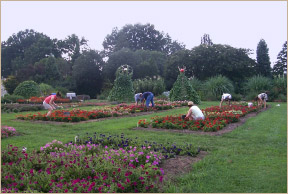 Evening
Gardening
Evening
Gardening
The bending and stooping (see photo above) really paid off! Thank you for such a great response! Bob Lyons, who led the group, was not at all surprised at the success of this endeavor! Much of the team's efforts focused on weeding and deadheading the Annual Plant Trials and Demonstration Area beds. Many industry visitors attending the field day commented on the annuals' fine grooming! Thanks to: Irene Campbell, Dennis Carey, Stephanie Distefano, Alan and Cynthia Dowdy, Wendy Elliott, Carole Fine, Wayne Friedrich, Kathy Hafer, Tim Hinton, Jeanette King, Julie Lovett, Donna Moffett, Sandy Reid, Lynn Scott, and Ann Swallow. An extra note of appreciation goes out to Bernadette Clark, Research Technician, and Cindy Lambert, Student Assistant, who assisted in the coordination.
Special thanks also goes to Jeanette King and Sandy Reid for watering and weeding the Paradise Garden every Wednesday evening along with John Suddath who provided the weekly watering and weeding of the Butterfly Garden.
Spreading the JCRA Word...
Many volunteers did this in many ways at many different events! It is impossible to name every occasion, so here are a few of the key efforts.
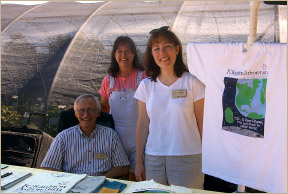 Plant
Delights Open Houses: Michelle and Tony Avent extended a much-appreciated invitation for us to talk up the JCRA to their many
customers! This proved to be a success not only in the new memberships and the
apparel sales, but also in spreading the word to new Triangle residents and
reminding long-time residents that have not visited lately! Thanks to those
who spread the word: Anna Berry, Virg Birgin, Dennis Carey, Genelle Dail, Roy Dicks, Wendy Elliott, Wayne Friedrich, Shelley Griffin, Dollie Glaum, Peg Henderson, Amelia Lane, Donna Moffett, Cecelia Morgan, Bonnie O'Connor, Beth Parks, Anne Stellings, John Suddath, Bobby Ward, Dee Welker, Nancy Zartarian, and Alice Zawadzki.
Plant
Delights Open Houses: Michelle and Tony Avent extended a much-appreciated invitation for us to talk up the JCRA to their many
customers! This proved to be a success not only in the new memberships and the
apparel sales, but also in spreading the word to new Triangle residents and
reminding long-time residents that have not visited lately! Thanks to those
who spread the word: Anna Berry, Virg Birgin, Dennis Carey, Genelle Dail, Roy Dicks, Wendy Elliott, Wayne Friedrich, Shelley Griffin, Dollie Glaum, Peg Henderson, Amelia Lane, Donna Moffett, Cecelia Morgan, Bonnie O'Connor, Beth Parks, Anne Stellings, John Suddath, Bobby Ward, Dee Welker, Nancy Zartarian, and Alice Zawadzki.
Encore Open House: Viv Finkelstein and Dick Pearson represented us well at this event. Thanks to you both for your extra efforts in running with this activity!
Special Events
2001: A Plant Odyssey: The symposium was a huge success. Thanks to the following volunteers who were most instrumental in making this happen: Claude and Mary Caldwell, Dennis Carey, Susan Cheatham, Carolyn Fagan, Viv Finkelstein, Donna Maroni, Heidi Miller, Austin Proctor, Priscilla Swindoll, Dick and Judith Tyler, and Jan Wilson.
Volunteers also made a significant contribution to the Annual Friends of the Arboretum Plant Distribution held October 6, 2001. Thanks to the many volunteers that helped prepare the plants. Kudos to those volunteers that persevered on that rainy Saturday morning of the distribution showing up in high spirits at 7:00 AM! Kathleen and Walt Thompson organized and set up every detail of the apparel sales and complimentary refreshments. Genelle Dail pitched in and was most involved with the $350.00+ of apparel sales. Sally Comer assisted by serving coffee and cookies to the members waiting in line - soaking wet but always smiling. Cynthia Dowdy, Wayne Friedrich, Barb Kennedy, and Sharon Mackey handled registering the 250+ members and the signing up of 42 new members. Tim Hinton, Harley Mudge, and Ed Ponek assisted with managing the line. Great job, crew - thanks for a fun time!
Tour Notes
Great season Tour Guides! You led 94 group tours and 29 Sunday tours for just under 450 volunteer hours. Thanks for sharing the Arboretum with so many visitors - many for the first time. Our appreciation goes to all of the tour guides that shared their interest in the Arboretum with others.
Special thanks to Dick Pearson, Kathe Rauch, and Viv Finkelstein who led over 15 tours each. Genelle Dail and Guy Meilleur led over 10 tours each and Susan Hyte, Claude and Mary Caldwell, Dollie Glaum, Barb Kennedy, and Bev Norwood led five or more each. Appreciation also goes out to Elizabeth Abrams who handles scheduling; Anna Absher, Tour Guide Coordinator; and Carolyn Fagan, Volunteer Office staff, who backs up the coordination effort!
Corrections/Omissions
Gail Harris, who regularly works with the Klein-Pringle White Garden team, arranged for the bus for the spring field trip.
Bob Roth, Lath House Curator put in over 200 volunteer hours in 2000 and was (and continues to be) a top volunteer both in curating and engraving.
Thank you both for past efforts as well as on-going volunteer contributions. Sorry for the error!
 Farewell
and Welcome!
Farewell
and Welcome!
Chris Allen (pictured above right) has been dutifully tending the Butterfly Garden as Curator since May 1999. There was hardly ever an early Sunday morning that you would not find Chris planting, watering, or weeding. Often working in the Paradise Garden during those same hours, I got to know Chris. She was most helpful with sharing graduate school strategies as she was in a doctoral program focused on microbiology. Upon completing her program at NCSU, Chris has taken advantage of an opportunity back home in Oklahoma. Thanks so much for your dedication - you will be missed!
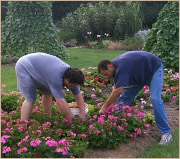 |
We welcome Wendy Elliott who is anxious to carry on Chris' work as the Butterfly Garden Curator. Wendy is a psychologist as well as a graduate student in Horticultural Science. Do make time to get to know her!
Formatted into HTML
by Christopher Todd Glenn
Programs & Education Coordinator
JC Raulston Arboretum
Department of Horticultural Science
North Carolina State University
Raleigh, NC 27695-7609
© The JC Raulston Arboretum, January 2002





